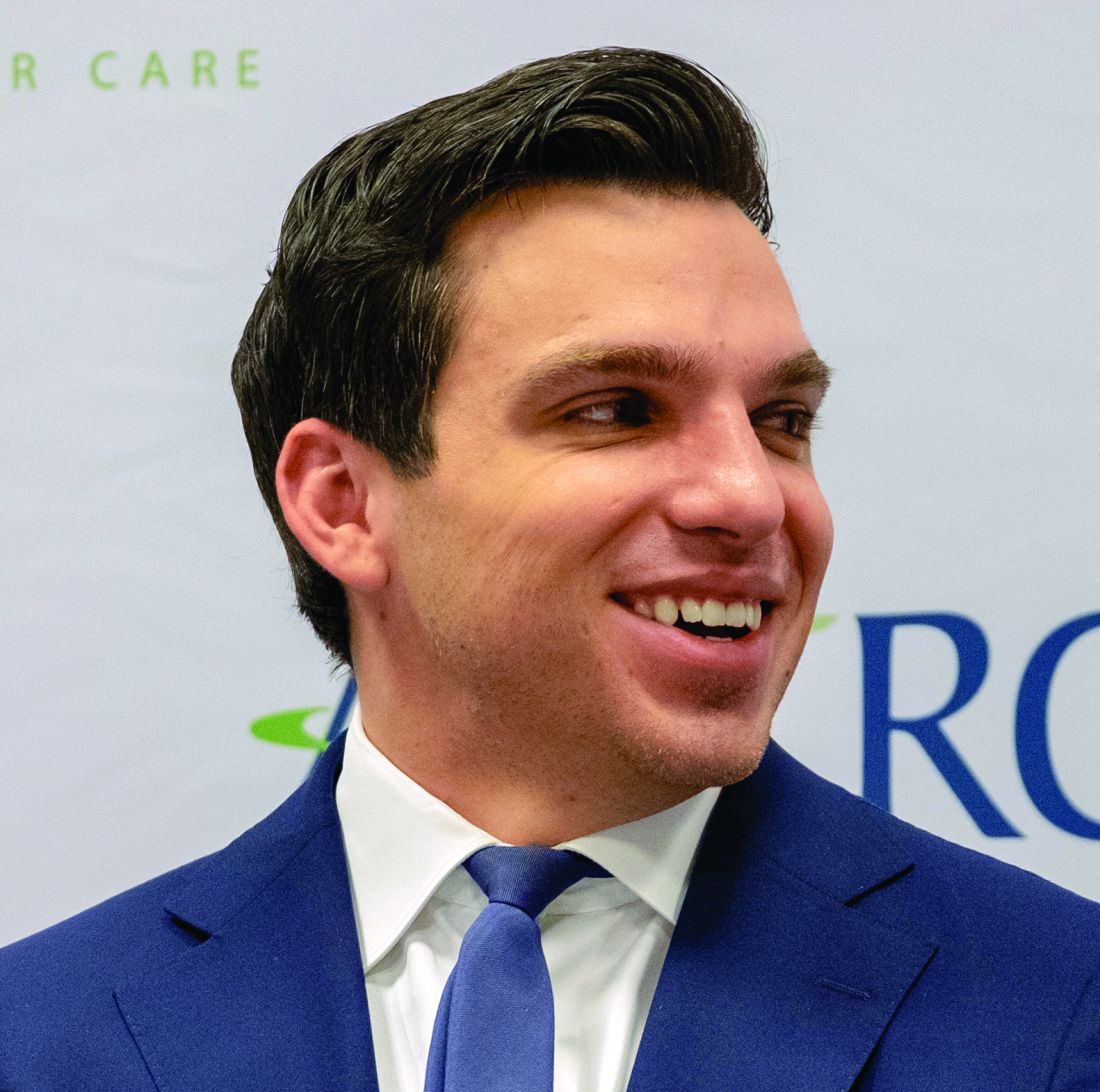User login
For men with prostate cancer who have a low prostate-specific antigen (PSA) level prior to salvage radiation therapy (SRT), adding an antiandrogen may increase the risk of other-cause mortality by twofold or more, according to investigators.
This finding was drawn from a secondary analysis of the NRG Oncology/RTOG 9601 phase 3 trial, a practice-changing study that showed that 2 years of antiandrogen therapy with bicalutamide improved overall survival when added to SRT, compared with that of SRT alone.
Results from the present analysis paint a more complex picture, revealing that patients with low PSA levels who received hormone therapy had a higher rate of other-cause mortality, primarily because of high-grade cardiac and neurologic events, reported lead author Daniel Spratt, MD, of the University of Michigan Rogel Cancer Center, Ann Arbor, who presented findings at the annual meeting of the American Society for Radiation Oncology.
Dr. Spratt described how treatment paradigms have changed since RTOG 9601 began in 1998, which prompted a revisitation of the trial. “Almost half of the men [in the trial] had a persistently elevated PSA after they underwent their initial surgery,” Dr. Spratt said. “This is uncommonly seen today. Additionally, about 60% of patients received what we call late salvage radiation therapy, where PSA was monitored and continued to rise beyond 0.5 [ng/mL]; again, this is not what is recommended to be used today.”
In the present analysis, the investigators stratified patients by PSA level. Of the 760 men involved, 85% had a PSA of 0.2-1.5 ng/mL. Patients were further subgrouped by those with a PSA of 0.2-0.6 ng/mL and those with a very low PSA, of 0.2-0.3 ng/mL. Multiple endpoints were assessed, including overall survival, other-cause mortality, distant metastasis, and rates of grade 3-5 cardiac or neurologic events.
The analysis showed that men with a PSA greater than 1.5 ng/mL had improved survival (hazard ratio, 0.45; 95% confidence interval, 0.25-0.81) when treated with bicalutamide, but those with PSA of 1.5 ng/mL or less did not (HR, 0.87; 95% CI, 0.66-1.16). Looking more closely at patients with a PSA of 1.5 ng/mL or less, those with a PSA of 0.2-0.6 ng/mL had a twofold increased rate of other-cause mortality (subdistribution HR, 1.94; P = .009). The picture became even more concerning for patients with a PSA of 0.2-0.3 ng/mL who were treated with bicalutamide: They had a fourfold increased risk of other cause mortality (sHR, 4.14). Among the cases with elevated other-cause mortality, grade 3-4 cardiac and neurologic events were likely to be blamed.
“What is likely driving this, and of concern, is that for [patients with a] PSA of less than 1.5 [ng/mL] … there was a three- to four-and-a-half-fold increased risk of high grade cardiac events,” Dr. Spratt said.
“The current guidelines recommend that all men be offered hormone therapy when receiving salvage radiation therapy, but our data demonstrate that men with lower PSA’s are probably more harmed than helped by long-term hormone therapy,” Dr. Spratt concluded. “We now have three randomized trials with over 2,400 men in total, [none of which showed that] short- or long-term hormone therapy improves overall survival in men [with a low PSA level who receive] early salvage radiotherapy. Thus, PSA prior to salvage radiation actually is not only prognostic, it predicts who will benefit most from hormone therapy, and guidelines should now be updated to reflect this finding.”
The session moderator, Anthony Zietman, MD, of Massachusetts General Hospital, Boston, helped put the findings in perspective: “This really suggests that we’ve got to hold back a little,” Dr. Zietman said. “There are some people who really benefit [from hormone therapy], some who don’t benefit, and some who just might be harmed, so I think we can be much more thoughtful and cautious in the future. … Thirty thousand men a year are in this situation who could be receiving this treatment. You could fill Fenway Park with that many people. So there are some big downstream implications. From here on out, I’m going to be a lot more cautious with my patients.”
The study was primarily funded by AstraZeneca with additional support from the Korea Institute of Radiological and Medical Sciences. The investigators disclosed relationships with Novartis, Roche, Amgen, and others.
SOURCE: Spratt et al. ASTRO 2019, Abstract LBA1.
For men with prostate cancer who have a low prostate-specific antigen (PSA) level prior to salvage radiation therapy (SRT), adding an antiandrogen may increase the risk of other-cause mortality by twofold or more, according to investigators.
This finding was drawn from a secondary analysis of the NRG Oncology/RTOG 9601 phase 3 trial, a practice-changing study that showed that 2 years of antiandrogen therapy with bicalutamide improved overall survival when added to SRT, compared with that of SRT alone.
Results from the present analysis paint a more complex picture, revealing that patients with low PSA levels who received hormone therapy had a higher rate of other-cause mortality, primarily because of high-grade cardiac and neurologic events, reported lead author Daniel Spratt, MD, of the University of Michigan Rogel Cancer Center, Ann Arbor, who presented findings at the annual meeting of the American Society for Radiation Oncology.
Dr. Spratt described how treatment paradigms have changed since RTOG 9601 began in 1998, which prompted a revisitation of the trial. “Almost half of the men [in the trial] had a persistently elevated PSA after they underwent their initial surgery,” Dr. Spratt said. “This is uncommonly seen today. Additionally, about 60% of patients received what we call late salvage radiation therapy, where PSA was monitored and continued to rise beyond 0.5 [ng/mL]; again, this is not what is recommended to be used today.”
In the present analysis, the investigators stratified patients by PSA level. Of the 760 men involved, 85% had a PSA of 0.2-1.5 ng/mL. Patients were further subgrouped by those with a PSA of 0.2-0.6 ng/mL and those with a very low PSA, of 0.2-0.3 ng/mL. Multiple endpoints were assessed, including overall survival, other-cause mortality, distant metastasis, and rates of grade 3-5 cardiac or neurologic events.
The analysis showed that men with a PSA greater than 1.5 ng/mL had improved survival (hazard ratio, 0.45; 95% confidence interval, 0.25-0.81) when treated with bicalutamide, but those with PSA of 1.5 ng/mL or less did not (HR, 0.87; 95% CI, 0.66-1.16). Looking more closely at patients with a PSA of 1.5 ng/mL or less, those with a PSA of 0.2-0.6 ng/mL had a twofold increased rate of other-cause mortality (subdistribution HR, 1.94; P = .009). The picture became even more concerning for patients with a PSA of 0.2-0.3 ng/mL who were treated with bicalutamide: They had a fourfold increased risk of other cause mortality (sHR, 4.14). Among the cases with elevated other-cause mortality, grade 3-4 cardiac and neurologic events were likely to be blamed.
“What is likely driving this, and of concern, is that for [patients with a] PSA of less than 1.5 [ng/mL] … there was a three- to four-and-a-half-fold increased risk of high grade cardiac events,” Dr. Spratt said.
“The current guidelines recommend that all men be offered hormone therapy when receiving salvage radiation therapy, but our data demonstrate that men with lower PSA’s are probably more harmed than helped by long-term hormone therapy,” Dr. Spratt concluded. “We now have three randomized trials with over 2,400 men in total, [none of which showed that] short- or long-term hormone therapy improves overall survival in men [with a low PSA level who receive] early salvage radiotherapy. Thus, PSA prior to salvage radiation actually is not only prognostic, it predicts who will benefit most from hormone therapy, and guidelines should now be updated to reflect this finding.”
The session moderator, Anthony Zietman, MD, of Massachusetts General Hospital, Boston, helped put the findings in perspective: “This really suggests that we’ve got to hold back a little,” Dr. Zietman said. “There are some people who really benefit [from hormone therapy], some who don’t benefit, and some who just might be harmed, so I think we can be much more thoughtful and cautious in the future. … Thirty thousand men a year are in this situation who could be receiving this treatment. You could fill Fenway Park with that many people. So there are some big downstream implications. From here on out, I’m going to be a lot more cautious with my patients.”
The study was primarily funded by AstraZeneca with additional support from the Korea Institute of Radiological and Medical Sciences. The investigators disclosed relationships with Novartis, Roche, Amgen, and others.
SOURCE: Spratt et al. ASTRO 2019, Abstract LBA1.
For men with prostate cancer who have a low prostate-specific antigen (PSA) level prior to salvage radiation therapy (SRT), adding an antiandrogen may increase the risk of other-cause mortality by twofold or more, according to investigators.
This finding was drawn from a secondary analysis of the NRG Oncology/RTOG 9601 phase 3 trial, a practice-changing study that showed that 2 years of antiandrogen therapy with bicalutamide improved overall survival when added to SRT, compared with that of SRT alone.
Results from the present analysis paint a more complex picture, revealing that patients with low PSA levels who received hormone therapy had a higher rate of other-cause mortality, primarily because of high-grade cardiac and neurologic events, reported lead author Daniel Spratt, MD, of the University of Michigan Rogel Cancer Center, Ann Arbor, who presented findings at the annual meeting of the American Society for Radiation Oncology.
Dr. Spratt described how treatment paradigms have changed since RTOG 9601 began in 1998, which prompted a revisitation of the trial. “Almost half of the men [in the trial] had a persistently elevated PSA after they underwent their initial surgery,” Dr. Spratt said. “This is uncommonly seen today. Additionally, about 60% of patients received what we call late salvage radiation therapy, where PSA was monitored and continued to rise beyond 0.5 [ng/mL]; again, this is not what is recommended to be used today.”
In the present analysis, the investigators stratified patients by PSA level. Of the 760 men involved, 85% had a PSA of 0.2-1.5 ng/mL. Patients were further subgrouped by those with a PSA of 0.2-0.6 ng/mL and those with a very low PSA, of 0.2-0.3 ng/mL. Multiple endpoints were assessed, including overall survival, other-cause mortality, distant metastasis, and rates of grade 3-5 cardiac or neurologic events.
The analysis showed that men with a PSA greater than 1.5 ng/mL had improved survival (hazard ratio, 0.45; 95% confidence interval, 0.25-0.81) when treated with bicalutamide, but those with PSA of 1.5 ng/mL or less did not (HR, 0.87; 95% CI, 0.66-1.16). Looking more closely at patients with a PSA of 1.5 ng/mL or less, those with a PSA of 0.2-0.6 ng/mL had a twofold increased rate of other-cause mortality (subdistribution HR, 1.94; P = .009). The picture became even more concerning for patients with a PSA of 0.2-0.3 ng/mL who were treated with bicalutamide: They had a fourfold increased risk of other cause mortality (sHR, 4.14). Among the cases with elevated other-cause mortality, grade 3-4 cardiac and neurologic events were likely to be blamed.
“What is likely driving this, and of concern, is that for [patients with a] PSA of less than 1.5 [ng/mL] … there was a three- to four-and-a-half-fold increased risk of high grade cardiac events,” Dr. Spratt said.
“The current guidelines recommend that all men be offered hormone therapy when receiving salvage radiation therapy, but our data demonstrate that men with lower PSA’s are probably more harmed than helped by long-term hormone therapy,” Dr. Spratt concluded. “We now have three randomized trials with over 2,400 men in total, [none of which showed that] short- or long-term hormone therapy improves overall survival in men [with a low PSA level who receive] early salvage radiotherapy. Thus, PSA prior to salvage radiation actually is not only prognostic, it predicts who will benefit most from hormone therapy, and guidelines should now be updated to reflect this finding.”
The session moderator, Anthony Zietman, MD, of Massachusetts General Hospital, Boston, helped put the findings in perspective: “This really suggests that we’ve got to hold back a little,” Dr. Zietman said. “There are some people who really benefit [from hormone therapy], some who don’t benefit, and some who just might be harmed, so I think we can be much more thoughtful and cautious in the future. … Thirty thousand men a year are in this situation who could be receiving this treatment. You could fill Fenway Park with that many people. So there are some big downstream implications. From here on out, I’m going to be a lot more cautious with my patients.”
The study was primarily funded by AstraZeneca with additional support from the Korea Institute of Radiological and Medical Sciences. The investigators disclosed relationships with Novartis, Roche, Amgen, and others.
SOURCE: Spratt et al. ASTRO 2019, Abstract LBA1.
FROM ASTRO 2019


